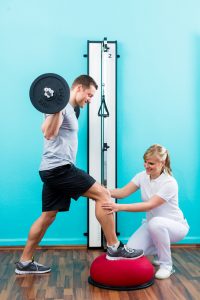Posted on October 11, 2018 by Jenny Cromack
The Need For Active Therapy

If you regularly have a sports massage, should actually be considering exercise rehabilitation?Being a therapist I see a lot of clients who all love a sports massage, but is sports massage worth it? Sports massage is a great tool in a therapists armour and has many benefits for our clients. In reality, however, massage is not a fix to our pain and injury problems. It is great at relieving symptoms and providing an initial reduction in muscular spasm and joint pain. If we don’t tackle these problems at source, however, they will simply keep occurring and you will have to fork out your hard earned cash week-on-week.
Not to do myself out of work, but I always advise my clients that the best therapist for their pain is them. They need to invest in the active side of treatment – or exercise rehabilitation, which consists of more than just tugging on a theraband that everyone seems to associate with rehabilitation.
What Does Exercise Rehabilitation Include?
Exercise rehabilitation can be as creative as you make it. The best exercise rehabilitation plans match to not only the clients injury needs, but also their sporting or physical activity needs and preferences. We know that massage can help with overly tight muscles and help remove those pesky trigger points, but this does not fix the causal factor of these spasms. To compliment our massage we need to target the culprits, which usually consist of the following factors:
- Muscle Weakness,
- Muscle Imbalance,
- Joint Stiffness,
- Mechanical Inefficiency,
- Postural Deficiencies.
Massage will not fix these issues. They may help temporarily alter some postural issues, but our posture is an active process so without working the active tissues we won’t change it. We need to work on the above elements to keep our bodies injury and pain free. But how do we do it? This article does not go into specific exercises as this would be very client specific.
The following, however, builds on the previous list and will detail the aims and exercise methods that you could expect from a rehabilitation session.
Muscle Weakness & Imbalance;
- Identify weakness through tests,
- Select movements to target weak areas in functional movement patterns.
- Lengthen overactive tissues (through stretching and/or massage) and activate its antagonistic partner muscle.
Joint Stiffness;
- Use active movement patterns to increase range of movement,
- Use active and equipment aided (e.g., bands) manipulation techniques to loosen inert structures and mobilise joint surfaces.
Mechanical Insufficiency;
- Use carefully selected exercises to retrain and recreate sport/function-specific movement patterns,
- Use specific full body functional movements to encourage full body stability and control.
Postural Deficiencies;
- Provide proprioceptive reference points, or a feel for, “normal” posture,
- Use a combination of muscle strengthening and mobility to achieve “normal” posture,
- Expose the body and “normal” posture to external stress and challenge and retrain ability to maintain control.
All of the above is just a list of what can be achieved from exercise rehabilitation. It is a frequently overlooked aspect of therapy as we all like being massaged for an hour. Alone, however, massage is not very effective in the long-term. So, to really get the most out of your sessions and your money’s worth exercise therapy is key. Next weeks blog article will detail a specific exercise therapy session that I am currently working through with a client.

